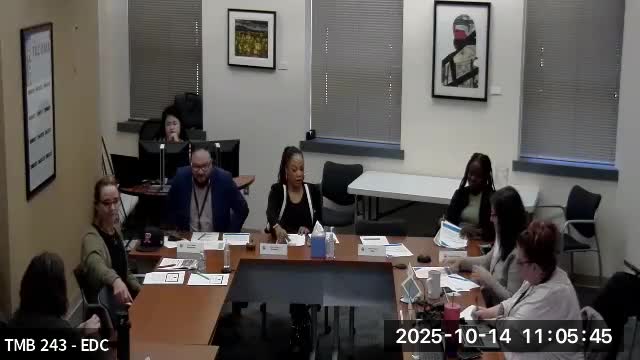Committee hears proposal to refresh Neighborhood Business District program, weigh nonprofit partner and funding gaps
October 14, 2025 | Tacoma, Pierce County, Washington
This article was created by AI summarizing key points discussed. AI makes mistakes, so for full details and context, please refer to the video of the full meeting. Please report any errors so we can fix them. Report an error »

The Economic Development Committee on Oct. 14 reviewed staff recommendations to refresh Tacoma’s Neighborhood Business District program, including a proposed role for a nonprofit fiscal sponsor and changes to funding and technical‑assistance models.
Carol Wolf, division manager for business services and workforce, and Sherry Hart, business program lead, presented a program history and the reasons for an update. Wolf said the program dates to the 1990s and was codified into city administrative code in 2008; staff said the refresh aims to increase program relevancy, capacity and impact. "We need to refresh for impact," Wolf said, adding that the city must balance what the department can own versus what it can influence or monitor.
Staff described Tacoma Neighborhoods Together (TNT), a city‑supported 501(c)(3) nonprofit that previously served as a fiscal sponsor for events and placemaking projects. Presenters said TNT can act as a technical and fiscal intermediary for business districts that lack nonprofit capacity, and staff are piloting administrative support models that use TNT in limited cases.
A key issue raised in the presentation is special‑event and public‑right‑of‑way costs. Staff gave an example of past council allocations and current barricade costs: a prior council allocation for barricade relief was cited as $20,000 across several districts; individual special‑event support that once ran at $2,000 can now require about $7,000 for barricades. Presenters said this change has strained volunteer‑based associations and reduced the number of events they can safely stage.
The refresh aims to:
- Clarify roles between business district associations, the cross‑district body, TNT and city staff;
- Pilot administrative support through Tacoma Neighborhoods Together and other intermediaries;
- Update eligibility beyond the original 14–15 Main‑Street style business districts to recognize pocket commercial areas and other organized associations;
- Co‑create program rules and funding distribution in 2026, with any legislative changes targeted for 2027.
Staff said they would take time through December to develop an action plan addressing capacity and funding distribution and expected to co‑create program updates with district stakeholders in 2026. Several council members urged the department to track vacancy costs, the city time spent supporting vacant properties, and permitting costs as part of district resiliency metrics.
No legislative vote was taken. Committee members expressed support for expanded technical assistance and a phased approach that begins with pilots. Staff said they will return with an action plan and drafts of program language for review.
Carol Wolf, division manager for business services and workforce, and Sherry Hart, business program lead, presented a program history and the reasons for an update. Wolf said the program dates to the 1990s and was codified into city administrative code in 2008; staff said the refresh aims to increase program relevancy, capacity and impact. "We need to refresh for impact," Wolf said, adding that the city must balance what the department can own versus what it can influence or monitor.
Staff described Tacoma Neighborhoods Together (TNT), a city‑supported 501(c)(3) nonprofit that previously served as a fiscal sponsor for events and placemaking projects. Presenters said TNT can act as a technical and fiscal intermediary for business districts that lack nonprofit capacity, and staff are piloting administrative support models that use TNT in limited cases.
A key issue raised in the presentation is special‑event and public‑right‑of‑way costs. Staff gave an example of past council allocations and current barricade costs: a prior council allocation for barricade relief was cited as $20,000 across several districts; individual special‑event support that once ran at $2,000 can now require about $7,000 for barricades. Presenters said this change has strained volunteer‑based associations and reduced the number of events they can safely stage.
The refresh aims to:
- Clarify roles between business district associations, the cross‑district body, TNT and city staff;
- Pilot administrative support through Tacoma Neighborhoods Together and other intermediaries;
- Update eligibility beyond the original 14–15 Main‑Street style business districts to recognize pocket commercial areas and other organized associations;
- Co‑create program rules and funding distribution in 2026, with any legislative changes targeted for 2027.
Staff said they would take time through December to develop an action plan addressing capacity and funding distribution and expected to co‑create program updates with district stakeholders in 2026. Several council members urged the department to track vacancy costs, the city time spent supporting vacant properties, and permitting costs as part of district resiliency metrics.
No legislative vote was taken. Committee members expressed support for expanded technical assistance and a phased approach that begins with pilots. Staff said they will return with an action plan and drafts of program language for review.
Don't Miss a Word: See the Full Meeting!
Go beyond summaries. Unlock every video, transcript, and key insight with a Founder Membership.
✓
Get instant access to full meeting videos
✓
Search and clip any phrase from complete transcripts
✓
Receive AI-powered summaries & custom alerts
✓
Enjoy lifetime, unrestricted access to government data
30-day money-back guarantee

